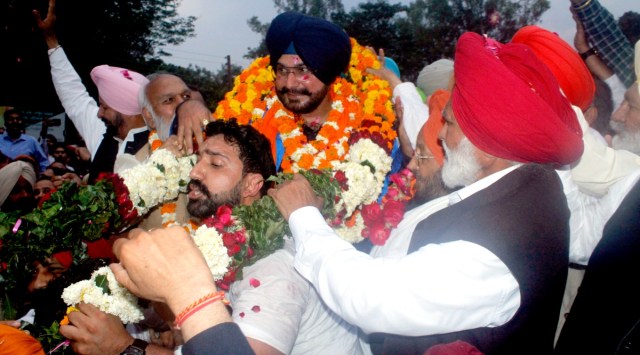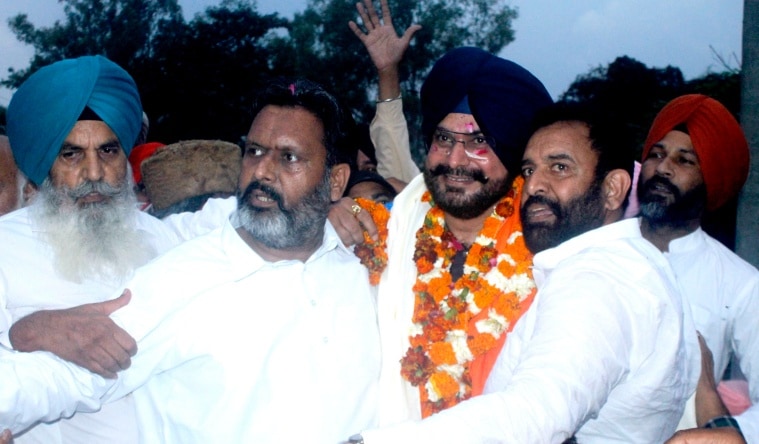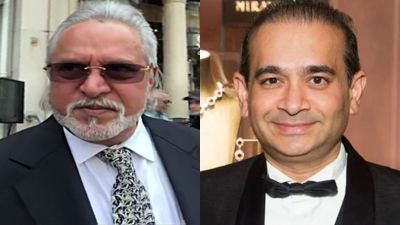Stay updated with the latest - Click here to follow us on Instagram
What SC based its verdict on: ‘some material aspects previously missed’
He was sentenced on May 19 last year and surrendered before a Patiala court a day later on May 20.
 Supporters of Congress leader Navjot Singh Sidhu welcome him after he is released from Patiala Central Jail. (Express Photo by Harmeet Sodhi)
Supporters of Congress leader Navjot Singh Sidhu welcome him after he is released from Patiala Central Jail. (Express Photo by Harmeet Sodhi) Less than a year after he was awarded one-year rigorous imprisonment in a 34-year-old road rage case by the Supreme Court, former Punjab Congress president Navjot Singh Sidhu was released from the Patiala Central Jail on Saturday.
The order by the top court, on May 19 2022, came on a review petition filed by the family of Gurnam Singh, 65, who had died allegedly after being assaulted by Sidhu and his friend. Gurnam’s family had sought review of a 2018 judgment that let Sidhu off with the fine.
Grand welcome for Navjot Singh Sidhu as he walked out of Patiala jail, Saturday | Video: @Navjeevan_Gopal @IndianExpress pic.twitter.com/ZR6O9YK5hx
— Express Punjab (@iepunjab) April 1, 2023
While awarding the sentence, a bench of Justices A M Khanwilkar and S K Kaul had said “some material aspects which were required to be taken note of appear to have been somehow missed out at the stage of sentencing,” such as “the then 25-year-old cricketer’s “physical fitness”.
The bench said there was “error apparent on the face of the record needing some remedial action”. It said “indulgence was not required to be shown at the stage of sentence by only imposing a sentence of fine and letting the respondent go without any imposition of a sentence”.
The court pointed out that Sidhu, at the time, “was an international cricketer, who was tall and well built and aware of the force of a blow that even his hand would carry” during the altercation that led to Gurnam Singh’s death in Patiala on December 27, 1988.
 Supporters of Congress leader Navjot Singh Sidhu welcome him after he comes out of Central Jail in Patiala on Saturday. (Express Photo by Harmeet Sodhi)
Supporters of Congress leader Navjot Singh Sidhu welcome him after he comes out of Central Jail in Patiala on Saturday. (Express Photo by Harmeet Sodhi)
“The blow was not inflicted on a person identically physically placed but a 65-year-old person, more than double his age,” it said, adding that Sidhu “cannot say that he did not know the effect of the blow or plead ignorance on this aspect”. The “hand can also be a weapon by itself where say a boxer, a wrestler or a cricketer or an extremely physically fit person inflicts the same”, it said.
The court said that while a disproportionately severe sentence should not be passed, a “manifestly inadequate”
sentence “would fail to produce a deterrent effect on the society at large”.
Social goal of sentencing
It said that “any undue sympathy to impose an inadequate sentence would do more harm to the justice system and undermine the public confidence in the efficacy of law”. “The society cannot long endure under serious threats and if the courts do not protect the injured, the injured would then resort to private vengeance,” the bench, adding that the punishment “should conform to and be consistent with the atrocity and brutality with which the crime has been perpetrated”.
Pointing to the need for proportionality, it said “the sentencing philosophy for an offence has a social goal that the sentence has to be based on the principle that the accused must realise that the crime committed by him has not only created a dent in his life but also a concavity in the social fabric”.
The court said criminal jurisprudence has with passage of time also laid emphasis on victimology, “which fundamentally is a perception of a trial from the viewpoint of the criminal as well as the victim”. “Both are viewed in the social context and, thus, victims’ rights have to be equally protected,” it said.
“Thus, when a 25 year old man, who was an international cricketer, assaults a man more than twice his age and inflicts, even with his bare hands, a severe blow on his (victim’s) head, the unintended consequence of harm would still be properly attributable to him as it was reasonably foreseeable,” the bench said.
#WATCH | Punjab: Dhols being played outside the jail in Patiala where Former Punjab Congress president Navjot Singh Sidhu, who was jailed in a road rage case, will be released today. pic.twitter.com/ktALjRs4qG
— ANI (@ANI) April 1, 2023
“A disproportionately light punishment”, said the court, “humiliates and frustrates a victim of crime when the offender goes unpunished or is let off with a relatively minor punishment as the system pays no attention to the injured’s feelings”.
“Indifference to the rights of the victim of crime is fast eroding the faith of the society in general and the victim of crime in particular in the criminal justice system,” the bench said.
According to the prosecution, Sidhu and his friend Rupinder Sandhu alias bunny were in a vehicle and had an altercation with Gurnam Singh after the latter asked them to give way. Police claimed that Singh was beaten up by Sidhu, who later fled the scene. The victim was taken to a hospital, where he was declared dead, the police said.
Sidhu and Sandhu were acquitted by the trial court in September 1999. But the Punjab and Haryana High Court reversed this order in December 2006 and convicted the two for culpable homicide not amounting to murder. Sidhu was sentenced to three years in prison.
The duo challenged this in the Supreme Court where a bench of Justices J Chelameswar and Kaul set the order aside and instead held Sidhu guilty under section 323 (voluntarily causing hurt) of the Indian Penal Code, and imposed the fine.
Timeline of the Case:
1988: On December 27, 1988, Navjot Sidhu and co-accused Rupinder Singh Sandhu alias Bunny engage in an altercation with Gurnam Singh, a Patiala resident, after he asked them to give way. The incident takes place near Sheranwala Gate in Patiala, Sidhu’s hometown. The police say that 65-year-old Gurnam was beaten up by Sidhu, who later fled the crime scene. Gurnam is taken to a hospital where he is declared dead.
1999: In September 1999, trial court acquits Sidhu and Bunny.
2006: In December 2006, Punjab and Haryana High Court holds Sidhu and Bunny guilty of culpable homicide not amounting to murder and sentences them to three years in jail.
2007: Sidhu and Bunny challenge the high court verdict in the Supreme Court, which stays the conviction pending appeal.
2018: Supreme Court holds Sidhu guilty for voluntarily causing hurt to Gurnam, reversing the Punjab and Haryana High Court verdict, and acquits Sidhu from culpable homicide not amounting to murder charge. In a verdict on May 15, 2018, Sidhu was fined Rs 1,000 under Section 323 of the Indian Penal Code. The SC takes into account that the incident was 30 years old, there was no enmity between the accused and deceased and that no weapon was used by the accused.
2018: Gurnam’s family moves Supreme Court with a review petition to treat the offence as more serious than just causing hurt and seeks punishment. The Supreme Court accepts the petition in September 2018.
2022: On May 19, Supreme Court awards one-year jail term to Navjot Singh Sidhu.







